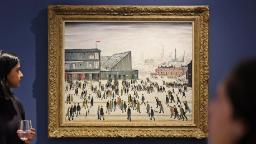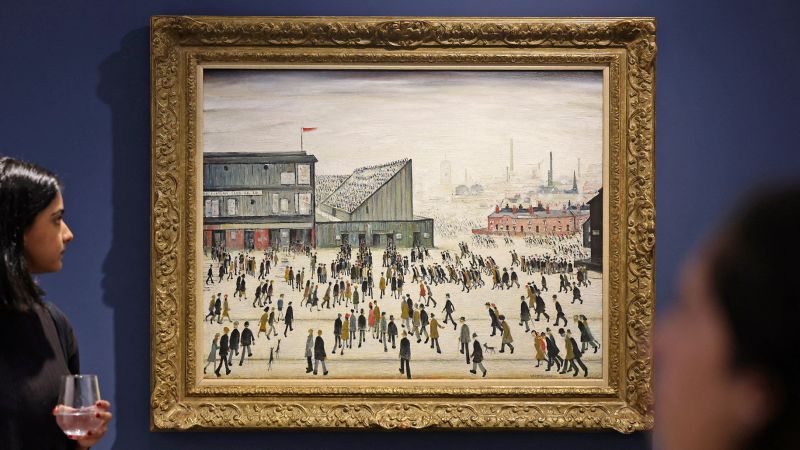‘It’s our Mona Lisa’: L.S. Lowry’s ‘Going to the Match’ faces uncertain future ahead of $9 million auction | CNN

CNN
—
It’s been described as “quite simply the finest football painting ever” and is estimated to fetch up to $9 million at auction later this month, but the sale of L.S. Lowry’s “Going to the Match” could see the much-loved artwork disappear from public display.
The 1953 painting, which depicts crowds of Lowry’s trademark, matchstick-style figures heading to a football stadium in the northwest of England, is up for auction on October 19, potentially putting an end to its 22-year residence at the Lowry museum in Salford.
The impending sale has stoked fears in the art community and beyond about the picture’s future, so much so that the Mayor of Salford has appealed to wealthy football clubs and players to purchase the painting and keep it in the public eye.
“There’s a very real risk that the work will come off public exhibition, and there’s a real risk that it might leave the country as well,” Michael Simpson, director of visual art at the Lowry, tells CNN.
The painting is expected to be sold for between $5.5 and $9 million (£5-8 million) at auction, according to Christie’s, and Simpson hopes a temporary export ban might ensure the work stays remains in the UK after it’s sold.
In such an instance, an independent committee would review the painting and advise the UK government on whether it is considered a national treasure and deemed “too important to leave the UK.”
Many feel that England’s northwest is a natural home for “Going to the Match” and its nostalgic depiction of crowds flocking to a football game.
The diminutive figures in the painting are heading to Burnden Park – the former, and now demolished, home of Bolton Wanderers – against the backdrop of factory chimneys and a grey, clouded sky.
A far cry from the billion-dollar industry of today’s Premier League, it provides a snapshot of what English football was like in the middle of the 20th century when spectators would head to matches straight from work on a Saturday.
“It’s probably the best football painting ever, in my opinion,” Mick Kirkbride, a London-based artist featured in the Football Art Prize exhibition, tells CNN.
“It just evokes everything about that release on a Saturday – going in your hoards and your bands and your tribes to that cathedral. And then the industrial backdrop says everything about where the game was born and where it flourished.”
Painted when Lowry was at the peak of his powers, “Going to the Match” – like much of the artist’s work – has grown in popularity in recent decades.
Today, nearly 50 years after his death, he is celebrated for his honest depictions of ordinary people leading ordinary lives.
Using a restricted and largely monochrome palette, Lowry captured brooding, industrial scenes around Manchester and Salford, amassing a prolific body of work over the course of his artistic career
He produced several works that focus on sporting events, but “Going to the Match” is the most renowned – as the painting’s estimated price tag would suggest.
“For northern, working-class people who like to look at paintings, it’s our Mona Lisa, really,” says Kirkbride. “For football fans it’s iconic … You can’t think of many iconic football paintings.”
The picture was bought by the Professional Footballers’ Association (PFA) – the union representing football players in England and Wales – in 1999 when then-CEO Gordon Taylor called it “quite simply the finest football painting ever.”
But the PFA is now having to sell the painting to fund its charitable work, which includes assisting ex-football players living with dementia.
The Mayor of Salford has launched a campaign for a temporary export ban to be attached to “Going to the Match” and wrote a letter imploring “[people] of means” to buy the painting and help keep it on public display in the city.
“It’s taken on its iconic status over the last 20-odd years when it’s been seen in public,” says Simpson, who thinks the Lowry museum has a “really good case” to continue displaying the painting after its sale.
“When it was in a private collection before that, relatively few people would know about it. But having it on public display has turned it into an icon and has increased its value significantly.”
The Lowry is a 15-minute walk from Manchester United’s Old Trafford stadium and benefits from increased footfall when the club has home games as a pre-match meeting point for fans.
“Loads of people come, they’ll have something to eat in our cafe and they’ll get a few drinks in the bar,” says Simpson. “They’ll go up and have a look at the painting, or they’ll just meet up with people before they go on to the match.”
But Simpson believes the upcoming World Cup in Qatar could incentivize overseas collectors to try and buy “Going to the Match,” and Kirkbride expects the painting to sell for more than its valuation given Lowry’s growing popularity.
“It’s the commodification of art versus the cultural heritage – it’s a clash of two ideologies,” says Kirkbridge. “Art’s a commodity, art’s currency. There’s a hard market going on out there … It’s very, very cutthroat.”
Whatever the outcome of the auction, efforts from the past few weeks to keep the painting on display in the UK are testament to Lowry’s artistic legacy and football’s nostalgic appeal.
“Anybody who’s been to a football match can see themselves in that picture because it’s more about the shared experience of seeing a match together and coming together at the match,” says Simpson.
“Lowry captures it wonderfully in that work.”
For all the latest Sports News Click Here

